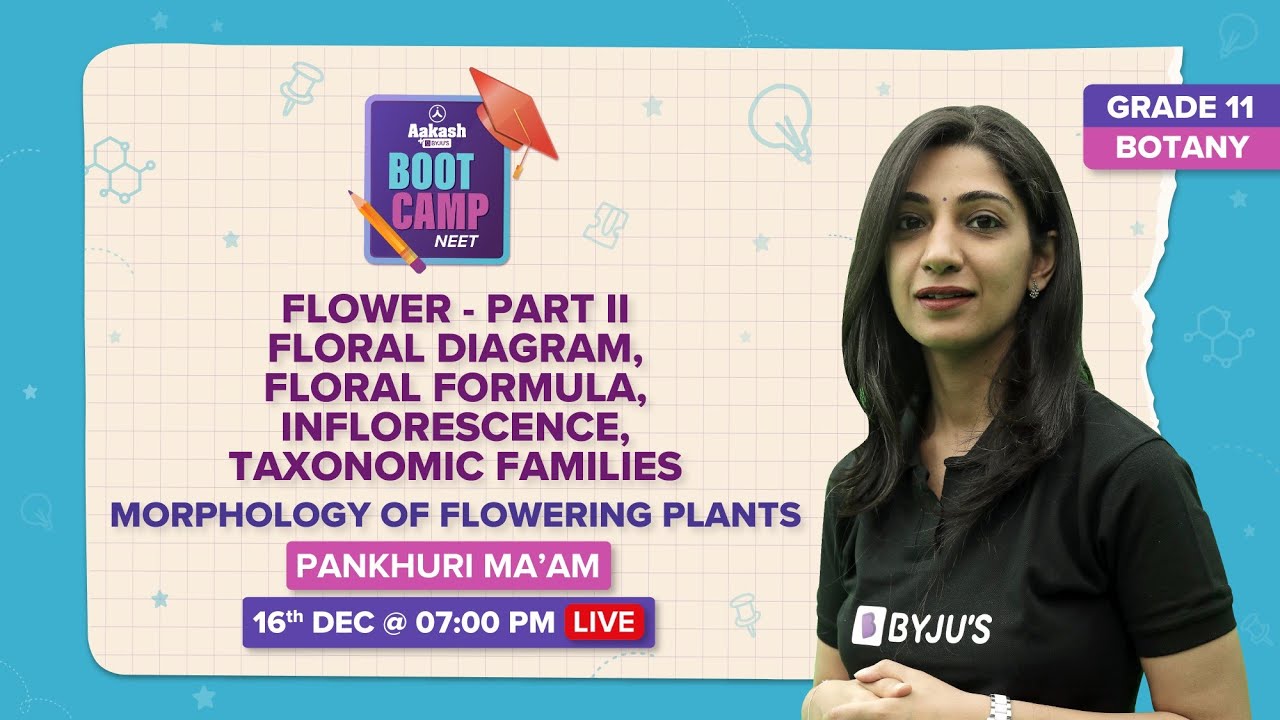Table of Content:
- What Is Floral Formula?
- Introduction To Floral Formulae
- Construction Of Floral Formulae
- Floral Symbols
- Writing Floral Formula
- Frequently Asked Questions
Download the Complete Guide to NEET UG Prep
Download Now
What Is Floral Formula?
“It is the numerical representation of the relative position and number of floral parts in relation to the mother axis or inflorescence axis”
Floral formulae are symbolic as well as numeric representations of different parts of a flower. It renders information on the type and number of organs, symmetry type, level of ovary, presence of fusions, and interrelationships of different floral parts which are corolla, calyx, androecium, and gynoecium.
However, floral formulae lack the information of details of organ position. American and European traditions differ in the way floral formulae are projected, while still delivering the same information. Floral formulae can be given for an entire family or for a specific species

Introduction To Floral Formulae
Flowers are determinate structures with a typically defined number of organs, bearing pistillate and staminate parts. Organs are set in four series – petals, sepals, stamens and carpels.
Floral formulae are a system to represent a flower’s structure using specific numbers, letters, and symbols, hence it is a simple way to present salient features of a flower. It portrays the number of parts, floral symmetry, connotation and adnation, ovary position and insertion. These formulae are beneficial to remember the characteristics of different angiosperm families. It mainly consists of 5 symbols which indicate:
- Number of sepals
- Number of petals
- Floral symmetry
- Number of carpels
- Number of stamens
Position of ovary
On the basis of the position of the corolla, calyx and androecium corresponding to the ovary on the thalamus, flowers can be described as hypogynous, epigynous and perigynous.
The gynoecium in the hypogynous flower occupies the highest position, other parts are located below it. Here the ovary is said to be superior. Such positioning of the ovary can be observed in brinjal, china rose and mustard flowers.
The margin of the thalamus in epigynous flowers, shoots upwards enveloping the ovary fully, thereby uniting with the other floral parts hence arising above the ovary. This is why it is said to be inferior as seen in the flowers of ray florets of sunflower, cucumber, and guava.
Perigynous is the condition observed in flowers, wherein the gynoecium is located in the center and floral parts are situated on the rim of the thalamus, at almost the same level. Ovaries here are half inferior as seen in flowers of peach, rose and plum.
Also Read: Difference between Androecium and Gynoecium
Construction Of Floral Formulae
- Floral whorls are represented in concentric circles. The outermost circle for sepals, second for petals, third for stamens and innermost for carpels
- Calyx is drawn as a circle of arcs with triangular tips towards outside. Petals are drawn as arcs with smooth surfaces alternating with sepals. If sepals/petals are free, then the arcs are free otherwise the margins of the arcs are joined by lines. Aestivation is shown by overlapping margins of arcs
- Stamens are represented as four-lobed structures for dithecous anthers and uniform shape for monothecous anthers and alternate with petals
- The gynoecium is represented in the center by showing the transverse section of the ovary
- A bract is drawn at the base and bracteoles towards the sides
- Mother axis is shown at the top of the floral diagram as a small circle with a dot
- A number assigned just after the symbol indicates the number of parts in that specific whole. If whorls are united, the number would be shown bracketed
- The presence of more than one whole of an organ is indicated by the representative parts. A flower having 3 whorls of five stamens each, is represented by the androecium in this way A5+5+5
- An arrow is made when one organ is united with the other, starting from the top of one symbol ending on top of the other symbol for the organ that is united.
- The missing organ is indicated by a 0 or zero after its respective symbol. If the number of organs in a whorl is more than 10, then the symbol will be followed by ∞
- A line placed over the number of carpels indicates the epigynous condition. Hypogynous condition is indicated by line under the number of carpels
Explore: Morphology of Flowering Plants
Floral Symbols
Floral formulae are used to describe a flower using some signs and symbols to designate different parts of a flower. Some of the different symbols used are as follows:
| Symbol | Description / Full form |
| Br | Bracteate condition |
| Ebr | Ebracteate condition |
| Brl | Bracteolate |
| Epik | Epicalyx |
| Ebrl | Ebracteolate |
| 0 (zero) | Absence of a particular whorl |
| ∞ | Indefinite number of floral parts in a whorl |
| ⊕ | Actinomorphic condition |
| % | Zygomorphic condition |
| K | Calyx (Sepals) |
| C | Corolla (petals) |
| P | Perianth (tepals) |
| A | Androecium (stamens) |
| G | Gynoecium (carpels) |
| ⚥ | Bisexual flower |
| ⚦ | Unisexual, staminate flower |
| ♀️ | Unisexual, pistillate flower |
| K5 | Five sepals, aposepalous |
| K(5) | Five sepals gamosepalous |
| C5 | Five petals, apopetalous |
| C(5) | Five petals, gamopetalous |
 |
Epiphyllous stamens |
 |
Epipetalous stamens |
| A3 | Three stamens free |
| A2+2 | Stamens 4, 2 whorls |
| A10+1 | Stamens 10, diadelphous – 9 stamens unite to form one bundle and 1 other bundle |
| A0 | Sterile stamen (staminode) |
| G0 | Sterile carpel (pistillode) |
| G- | Semi inferior ovary |
 |
Inferior ovary |
 |
Superior ovary |
The number of floral parts are indicated along with symbols at the base of a floral diagram and their union by showing a bracket.
Writing Floral Formula
When one begins to write the formula, start with bract and bracteole, moving to symmetry and sexuality of flowers and then specifying the floral parts – calyx, corolla, androecium, and gynoecium. To designate the numbers of parts of each structure, figures such as (1, 2, 3, 4, 5) are used after corresponding symbols of the floral part such as K (calyx), C (corolla), A (androecium) and G (gynoecium).
If the parts of the flower are fused, numeral value is placed in the bracket, but if parts are free, the value is placed as it is. If it is a bilabiate structure, the number of parts is split into two values based on parts in the upper and lower lip.
Joining the top of symbols of different whorls by an arc or curved line indicates the adnation of members. A vertical line between symbols of two floral cycles indicates a break in the alternation of parts of any two successive floral cycles. Whereas placing a horizontal line in front or above the symbol of gynoecium represents the position of the ovary if it is half inferior, superior, or inferior.
You just read about the floral formula. For more detailed information on floral parts, floral diagram, visit BYJU’S.
Recommended Video:


Also See:
| Types of Cymose Inflorescence |
| What is Racemose Inflorescence? |
Frequently Asked Questions
What is androecium and gynoecium?
Androecium and gynoecium are referred to as reproductive whorls of a flower. Androecium produces pollen grains comprising male gametes, while the gynoecium produces ovules that are female gametes. The former is composed of anthers and filaments and the latter is composed of style, stigma and ovary.
What are sepals and petals?
Petal is a type of modified leaf that is brightly colored. A collection of petals is referred to as a corolla. The petals are accompanied by another leaf modification called the sepals. A collection of sepals is termed as calyx.

Thank you so much sir